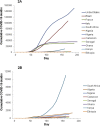What could explain the late emergence of COVID-19 in Africa?
- PMID: 32983542
- PMCID: PMC7508045
- DOI: 10.1016/j.nmni.2020.100760
What could explain the late emergence of COVID-19 in Africa?
Abstract
At the end of November 2019, a novel coronavirus responsible for respiratory tract infections emerged in China. Despite drastic containment measures, this virus, known as severe acute respiratory syndrome coronavirus 2 (SARS-CoV-2), spread in Asia and Europe. The pandemic is ongoing with a particular hotspot in southern Europe and America in spring 2020. Many studies predicted an epidemic in Africa similar to that currently seen in Europe and the USA. However, reported data do not confirm these predictions. Several hypotheses that could explain the later emergence and spread of the coronavirus disease 2019 (COVID-19) pandemic in African countries are being discussed, including the lack of health-care infrastructure capable of clinically detecting and confirming COVID-19 cases, the implementation of social distancing and hygiene, international air traffic flows, the climate, the relatively young and rural population, the genetic polymorphism of the angiotensin-converting enzyme 2 receptor, cross-immunity and the use of antimalarial drugs.
Keywords: Africa; antimalarial drugs; coronavirus disease 2019; malaria; severe acute respiratory syndrome coronavirus 2.
© 2020 The Author(s).
Figures





References
Publication types
LinkOut - more resources
Full Text Sources
Miscellaneous
